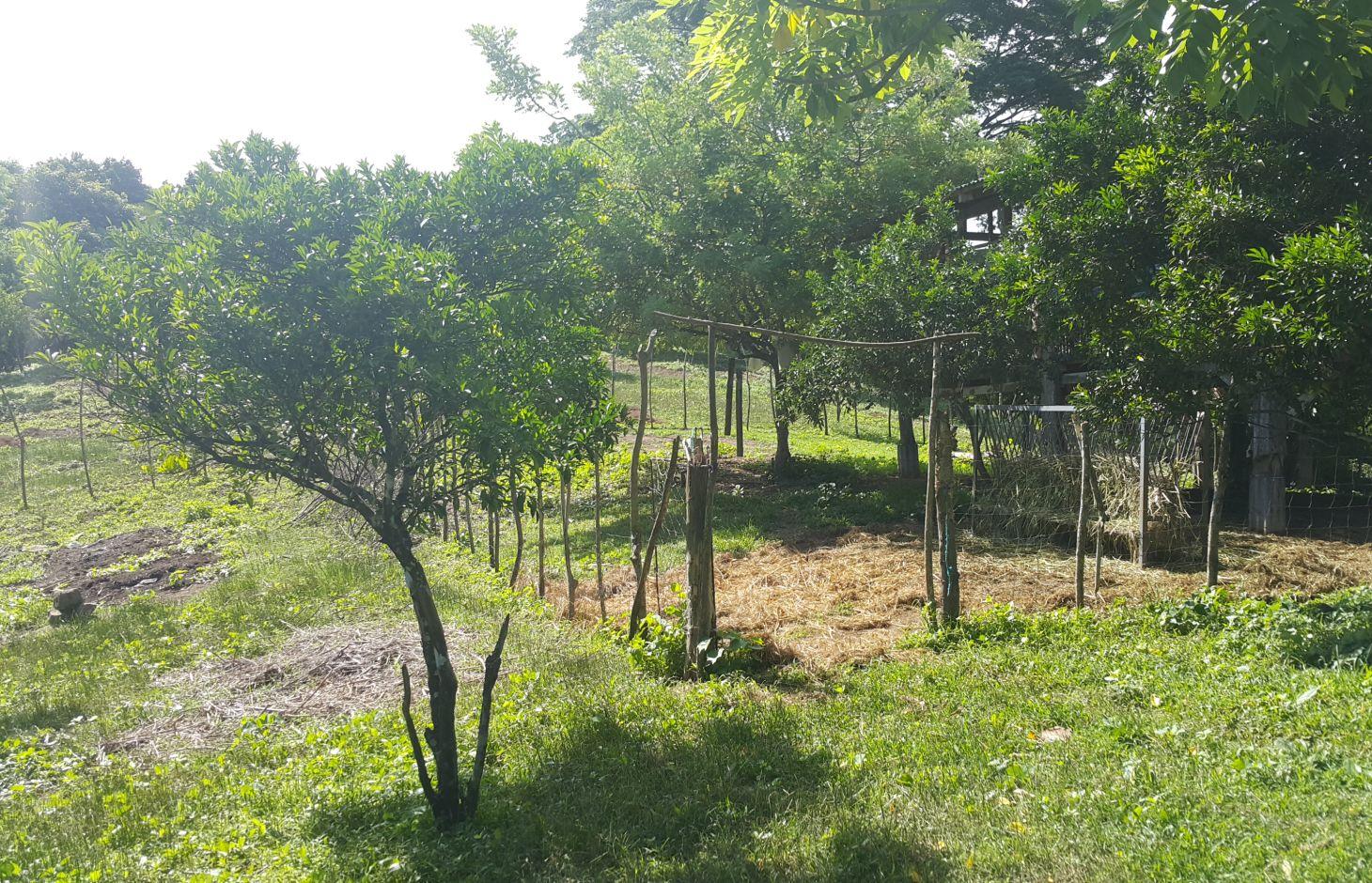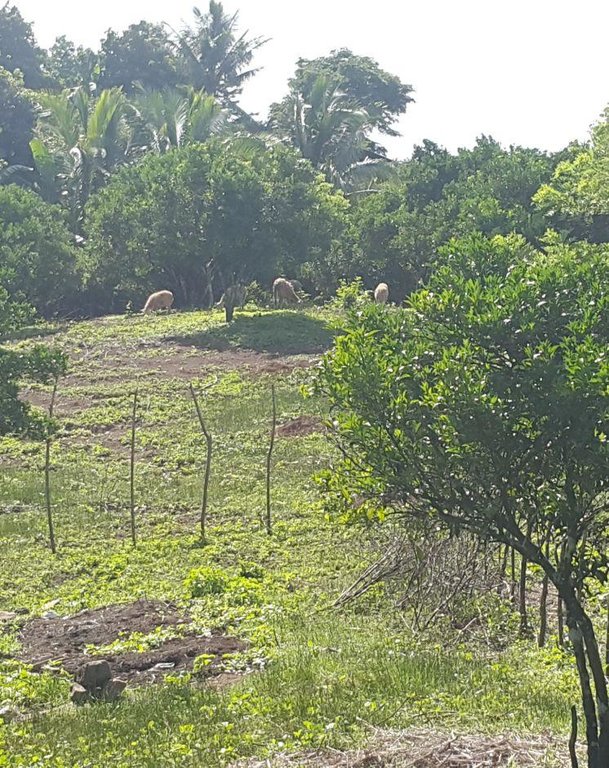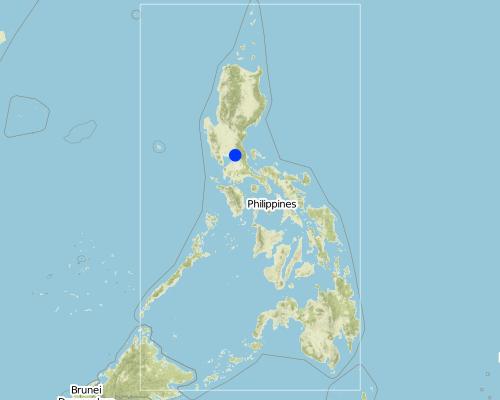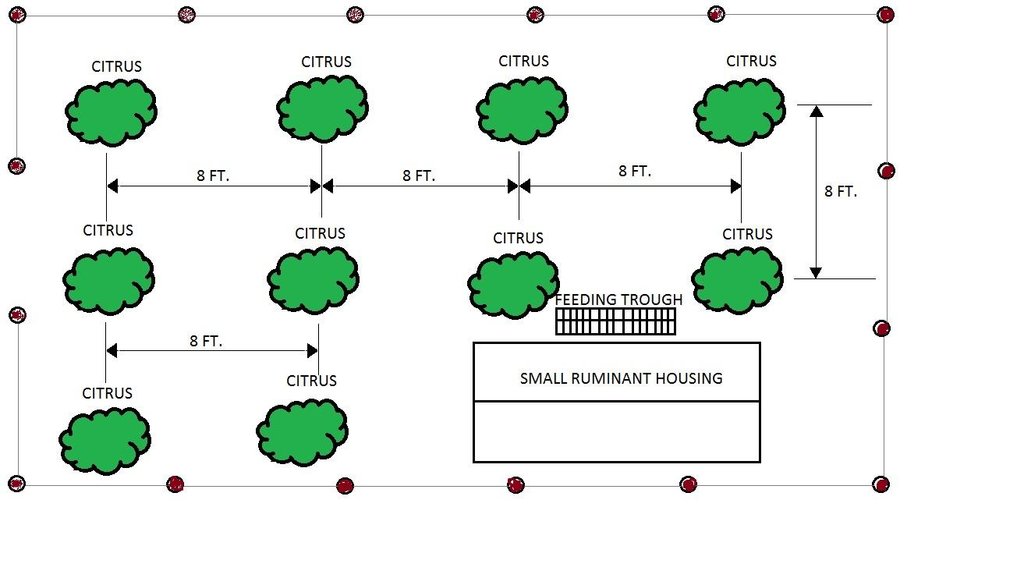Improved pasture under citrus [Philippines]
- Creation:
- Update:
- Compiler: Philippine Overview of Conservation Approaches and Technologies
- Editor: –
- Reviewer: Fabian Ottiger
Pastulan sa ilalim ng dalanghitaan (Filipino)
technologies_1321 - Philippines
View sections
Expand all Collapse all1. General information
1.2 Contact details of resource persons and institutions involved in the assessment and documentation of the Technology
Key resource person(s)
SLM specialist:
Rojales Jose
(632)9230459
Departement of Agriculture - Bureau of Soils and Water Management
Quezon City Elliptical Road corner Visayas Avenue, Diliman, Quezon City
Philippines
SLM specialist:
Calonge Arsenio
(632)9230459
Departement of Agriculture - Bureau of Soils and Water Management
Quezon City Elliptical Road corner Visayas Avenue, Diliman, Quezon City
Philippines
SLM specialist:
Millare Kirby
(632)9230459
Departement of Agriculture - Bureau of Soils and Water Management
Quezon City Elliptical Road corner Visayas Avenue, Diliman, Quezon City
Philippines
SLM specialist:
Quinto Jasmin
(632)9230459
Departement of Agriculture - Bureau of Soils and Water Management
Quezon City Elliptical Road corner Visayas Avenue, Diliman, Quezon City
Philippines
SLM specialist:
Gultiano Wilfredo
(632)9230459
Departement of Agriculture - Bureau of Soils and Water Management
Quezon City Elliptical Road corner Visayas Avenue, Diliman, Quezon City
Philippines
SLM specialist:
Cornes Jennelyn Mae
(632)9230459
Departement of Agriculture - Bureau of Soils and Water Management
Quezon City Elliptical Road corner Visayas Avenue, Diliman, Quezon City
Philippines
SLM specialist:
Name of the institution(s) which facilitated the documentation/ evaluation of the Technology (if relevant)
Bureau of Soils and Water Management (Bureau of Soils and Water Management) - Philippines1.3 Conditions regarding the use of data documented through WOCAT
When were the data compiled (in the field)?
29/06/2016
The compiler and key resource person(s) accept the conditions regarding the use of data documented through WOCAT:
Yes
1.5 Reference to Questionnaire(s) on SLM Approaches
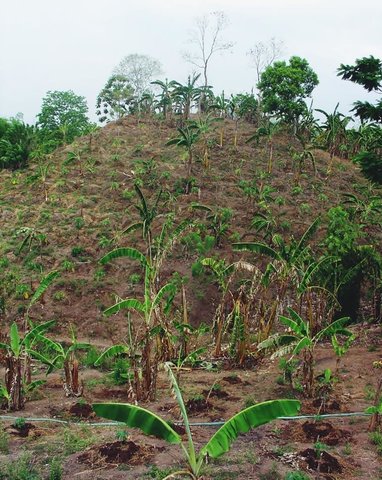
Soil Conservation Guided Farm System [Philippines]
Soil Conservation Guided Farming System (SCGFS) is a land use management approach that integrates technologies: terracing, agro-pastoral technology, multi-storey cropping, and contouring within the socio-economic and bio-physical limitations of upland areas for optimum development of soil and water resource in a sustainable manner.
- Compiler: Philippine Overview of Conservation Approaches and Technologies
2. Description of the SLM Technology
2.1 Short description of the Technology
Definition of the Technology:
It is a farming system that integrates the growing of fodder crops under plantation crops.
2.2 Detailed description of the Technology
Description:
It is an integration of livestock and agronomic crop production of incorporating small ruminants in an existing citrus plantation. This technology was based on the private initiative of the farmer where he adapted it from other land users. He further improved it through study of reading materials and ad hoc monitoring of his environment.
Purpose of the Technology: After the adaption of the technology, the land user observed a decrease in the infestation of aphids. The land user observed and concluded that the decline in the aphids infestation was due to the presence of the small ruminants in the area. The small ruminants forage on grasses that were continuously growing, year-round, in the plantation area. The foraging of grasses improved the micro-environment of the plantation crop, which contributed to the decline and almost total eradication of aphids in the area, as observed by the land user. This promoted natural farming and improved the biodiversity.
Establishment / maintenance activities and inputs: The area was first established as a citrus plantation inter-cropped with Vigna unguiculata, Cucurbita maxima, and Ipomoea batatas, as cash crop during the vegetative stage of the citrus crop. As the small ruminants increased in number, the land user decided to do “controlled grazing” by dividing the area into 3 paddocks. During lean days of forage grasses, the land user practices “cut-and-carry” system of feeding. In addition, the manure of the small ruminants serves as a source of organic fertilizer for the citrus and other crops grown by the land user.
Natural / human environment: Aside from the eradication of the aphids on the citrus crop, the technology aided in the financial needs of the land user. It increased the land user’s income by an increase in the fruits bore by the crop and the increase in the number of the small ruminants. The land user sells or sometimes suppliers of citrus fruit and goat meat would go to the area to do wholesale buying. As for the community near the area, they to benefit from the area, by wholesale buying the citrus fruit and be the one selling it to the market. The technology does not only contribute to the livelihood improvement of the land user but also to the community.
2.3 Photos of the Technology
2.5 Country/ region/ locations where the Technology has been applied and which are covered by this assessment
Country:
Philippines
Region/ State/ Province:
Bulacan
Further specification of location:
City of San Jose Del Monte
Map
×2.6 Date of implementation
If precise year is not known, indicate approximate date:
- less than 10 years ago (recently)
2.7 Introduction of the Technology
Specify how the Technology was introduced:
- through land users' innovation
- experience from other farm land user
Comments (type of project, etc.):
8 years
3. Classification of the SLM Technology
3.2 Current land use type(s) where the Technology is applied

Cropland
- Perennial (non-woody) cropping
Main crops (cash and food crops):
Major cash crop:
Citrus
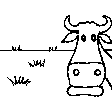
Grazing land
- Silvo-pastoralism
Main animal species and products:
Goat and sheep grazing in combination
Comments:
Major land use problems (compiler’s opinion): Possibility of pollution in the area. The land user might have applied pesticide to the citrus crops to control the pest, but the land user did not mention of it. Application of herbicide to control the growth of grasses within and outside the area.
Major land use problems (land users’ perception): Without land conservation, there was an occurrence of pest in the citrus plants.
Mixed: (eg agro-pastoralism, silvo-pastoralism): silvo-pastoralism, goat and sheep grazing in combination
Future (final) land use (after implementation of SLM Technology): Mixed: Ms: Silvo-pastoralism
If land use has changed due to the implementation of the Technology, indicate land use before implementation of the Technology:
Cropland: Cp: Perennial (non-woody) cropping
3.3 Further information about land use
Water supply for the land on which the Technology is applied:
- rainfed
Comments:
Water supply: rainfed, rainfed
Number of growing seasons per year:
- 1
Specify:
Longest growing period in days: 120Longest growing period from month to month: July to November
Livestock density (if relevant):
1-10 LU /km2
3.4 SLM group to which the Technology belongs
- integrated crop-livestock management
- integrated pest and disease management (incl. organic agriculture)
3.5 Spread of the Technology
Specify the spread of the Technology:
- evenly spread over an area
If the Technology is evenly spread over an area, indicate approximate area covered:
- < 0.1 km2 (10 ha)
Comments:
Total area covered by the SLM Technology is 0.08 m2.
3.6 SLM measures comprising the Technology

agronomic measures
- A1: Vegetation/ soil cover

vegetative measures
- V2: Grasses and perennial herbaceous plants
Comments:
Main measures: agronomic measures
Secondary measures: vegetative measures
Type of agronomic measures: mixed cropping / intercropping, manure / compost / residues
Type of vegetative measures: scattered / dispersed
3.7 Main types of land degradation addressed by the Technology

biological degradation
- Bp: increase of pests/ diseases, loss of predators
Comments:
Main type of degradation addressed: Bp: increase of pests / diseases, loss of predators
Main causes of degradation: crop management (annual, perennial, tree/shrub) (intercropping planting), droughts (time frame of drought)
Secondary causes of degradation: soil management (grazing of small ruminants), overgrazing (no. of small ruminants), change in temperature (dry season time frame)
3.8 Prevention, reduction, or restoration of land degradation
Specify the goal of the Technology with regard to land degradation:
- reduce land degradation
- restore/ rehabilitate severely degraded land
Comments:
Main goals: mitigation / reduction of land degradation
Secondary goals: rehabilitation / reclamation of denuded land
Third goal: prevention of land degradation, rehabilitation
4. Technical specifications, implementation activities, inputs, and costs
4.1 Technical drawing of the Technology
4.2 Technical specifications/ explanations of technical drawing
Citrus plants are evenly distributed in the area, with a planting distance of 8 feet by 8 feet. The ground cover are forage grasses for the small ruminants.
Location: Barangay San Roque. San Jose Del Monte, Bulacan
Date: 06/29/2016
Technical knowledge required for field staff / advisors: moderate (technical assistance from agricultural advisory from other aspect in land degradation)
Technical knowledge required for land users: high (land user is open minded with the technology introduced)
Main technical functions: improvement of ground cover, stabilisation of soil (eg by tree roots against land slides), increase in organic matter, increase in nutrient availability (supply, recycling,…), increase of biomass (quantity), promotion of vegetation species and varieties (quality, eg palatable fodder)
Secondary technical functions: control of raindrop splash, control of dispersed runoff: impede / retard, control of concentrated runoff: drain / divert, increase of surface roughness, increase of infiltration, reduction in wind speed, spatial arrangement and diversification of land use
Mixed cropping / intercropping
Material/ species: pole sitao-squash-sweet potato/citrus
Agronomic measure: intercropping (1st Year)
Material/ species: pole sitao/citrus
Quantity/ density: 2,000/188
Agronomic measure: intercropping (2nd year)
Material/ species: squash/ citrus
Quantity/ density: 2,000/188
Agronomic measure: intercropping (3rd year)
Material/ species: sweet potato/ citrus
Quantity/ density: 8,800/188
Manure / compost / residues
Material/ species: goat manure
Quantity/ density: 5,000 kg
Remarks: .5 per square meter
Scattered / dispersed
Vegetative material: G : grass
4.3 General information regarding the calculation of inputs and costs
other/ national currency (specify):
Philippine Peso
Indicate exchange rate from USD to local currency (if relevant): 1 USD =:
47.5
Indicate average wage cost of hired labour per day:
5.26
4.4 Establishment activities
| Activity | Type of measure | Timing | |
|---|---|---|---|
| 1. | rotational grazing | Vegetative | rainy season |
| 2. | cut-and-carry feeding system | Vegetative | dry season |
| 3. | Buying pole sitao | Agronomic | |
| 4. | Buying sqaush | Agronomic | |
| 5. | Buying citrus | Agronomic |
4.5 Costs and inputs needed for establishment
| Specify input | Unit | Quantity | Costs per Unit | Total costs per input | % of costs borne by land users | |
|---|---|---|---|---|---|---|
| Labour | Labour | ha | 1.0 | 10.52 | 10.52 | 100.0 |
| Plant material | Seeds | ha | 1.0 | 3160.0 | 3160.0 | 100.0 |
| Plant material | Seedlings | ha | 1.0 | 48.0 | 48.0 | 100.0 |
| Construction material | Hog wire | ha | 1.0 | 397.89 | 397.89 | 100.0 |
| Total costs for establishment of the Technology | 3616.41 | |||||
Comments:
Duration of establishment phase: 12 month(s)
Life span of products:
Pole Sitao - 1 year
Squash - 1 year
Citrus - 50 years
4.7 Costs and inputs needed for maintenance/ recurrent activities (per year)
| Specify input | Unit | Quantity | Costs per Unit | Total costs per input | % of costs borne by land users | |
|---|---|---|---|---|---|---|
| Labour | Labour | ha | 1.0 | 10.52 | 10.52 | 100.0 |
| Total costs for maintenance of the Technology | 10.52 | |||||
Comments:
The above costs usually occurs during the dry season when forage grasses are scarce. Lean months of availability of forages grasses are from the months April to June. This is the time the cut-and-carry method is applied and the start of the maintenance/recurrent cost.
4.8 Most important factors affecting the costs
Describe the most determinate factors affecting the costs:
Cut-and-carry method of feeding the small ruminants during lean months of forage grasses.
5. Natural and human environment
5.1 Climate
Annual rainfall
- < 250 mm
- 251-500 mm
- 501-750 mm
- 751-1,000 mm
- 1,001-1,500 mm
- 1,501-2,000 mm
- 2,001-3,000 mm
- 3,001-4,000 mm
- > 4,000 mm
Specify average annual rainfall (if known), in mm:
2382.00
Agro-climatic zone
- sub-humid
Thermal climate class: tropics
5.2 Topography
Slopes on average:
- flat (0-2%)
- gentle (3-5%)
- moderate (6-10%)
- rolling (11-15%)
- hilly (16-30%)
- steep (31-60%)
- very steep (>60%)
Landforms:
- plateau/plains
- ridges
- mountain slopes
- hill slopes
- footslopes
- valley floors
Altitudinal zone:
- 0-100 m a.s.l.
- 101-500 m a.s.l.
- 501-1,000 m a.s.l.
- 1,001-1,500 m a.s.l.
- 1,501-2,000 m a.s.l.
- 2,001-2,500 m a.s.l.
- 2,501-3,000 m a.s.l.
- 3,001-4,000 m a.s.l.
- > 4,000 m a.s.l.
Indicate if the Technology is specifically applied in:
- concave situations
Comments and further specifications on topography:
Landforms: Ridges (concave)
5.3 Soils
Soil depth on average:
- very shallow (0-20 cm)
- shallow (21-50 cm)
- moderately deep (51-80 cm)
- deep (81-120 cm)
- very deep (> 120 cm)
Soil texture (topsoil):
- medium (loamy, silty)
Topsoil organic matter:
- medium (1-3%)
If available, attach full soil description or specify the available information, e.g. soil type, soil PH/ acidity, Cation Exchange Capacity, nitrogen, salinity etc.
Soil fertility is: Medium
Soil drainage/infiltration is: Good
Soil water storage is: High
5.4 Water availability and quality
Availability of surface water:
good
Water quality (untreated):
for agricultural use only (irrigation)
5.5 Biodiversity
Species diversity:
- medium
5.6 Characteristics of land users applying the Technology
Market orientation of production system:
- subsistence (self-supply)
- mixed (subsistence/ commercial
Off-farm income:
- 10-50% of all income
Relative level of wealth:
- average
Individuals or groups:
- individual/ household
Level of mechanization:
- manual work
Gender:
- men
Indicate other relevant characteristics of the land users:
Land users applying the Technology are mainly common / average land users
Difference in the involvement of women and men: It is the countries socio-cultural model, where men is the one working and the women stay at home. According to the land user it is the women who is record keeper.
Population density: 10-50 persons/km2
Annual population growth: 0.5% - 1%
10% of the land users are average wealthy.
Off-farm income specification: off-farm income provides additional income to the land user during the dry season.
Market orientation: Subsistence (small ruminants are bought by the land user)
5.7 Average area of land owned or leased by land users applying the Technology
- < 0.5 ha
- 0.5-1 ha
- 1-2 ha
- 2-5 ha
- 5-15 ha
- 15-50 ha
- 50-100 ha
- 100-500 ha
- 500-1,000 ha
- 1,000-10,000 ha
- > 10,000 ha
Is this considered small-, medium- or large-scale (referring to local context)?
- small-scale
Comments:
Average area of land owned or leased by land users applying the Technology: < 0.5 ha, < 0.5 ha, 0.5-1 ha, 1-2 ha
5.8 Land ownership, land use rights, and water use rights
Land ownership:
- individual, titled
Land use rights:
- individual
Water use rights:
- communal (organized)
5.9 Access to services and infrastructure
health:
- poor
- moderate
- good
education:
- poor
- moderate
- good
technical assistance:
- poor
- moderate
- good
employment (e.g. off-farm):
- poor
- moderate
- good
markets:
- poor
- moderate
- good
energy:
- poor
- moderate
- good
roads and transport:
- poor
- moderate
- good
drinking water and sanitation:
- poor
- moderate
- good
financial services:
- poor
- moderate
- good
6. Impacts and concluding statements
6.1 On-site impacts the Technology has shown
Socio-economic impacts
Production
crop production
Quantity before SLM:
3,000 kilograms
Quantity after SLM:
8,000 kilograms
animal production
Quantity before SLM:
5
Quantity after SLM:
5
product diversity
land management
Income and costs
farm income
Quantity before SLM:
30,000
Quantity after SLM:
80,000
diversity of income sources
workload
Other socio-economic impacts
Improved livelihoods and human well-being
Comments/ specify:
It gave an opportunity to the neighbors of the land user to work at the field, with pay. Thus, an added income to the neighbor of the land user. According to the land user, he was able to send his children to a decent school for a quality education. It also gave the land user another source of income by purchasing a jeepney used as a public transportation through the increased income from the SLM technogy he adapted.
Socio-cultural impacts
food security/ self-sufficiency
Comments/ specify:
The increased in the income of the land user contributes to the food security of the family
health situation
Comments/ specify:
Daily chores of herding the small ruminants contributes to the good over health of the land user
SLM/ land degradation knowledge
Comments/ specify:
Rotational grazing and "cut-and-carry" style of feeding contributed to the possible overgrazing which is contributor to erosion
conflict mitigation
situation of socially and economically disadvantaged groups
Comments/ specify:
The land user allows the member of his community to harvest some fruits and sell them to the market without the land user asking for something in return.
Ecological impacts
Water cycle/ runoff
water quantity
water quality
surface runoff
Comments/ specify:
Rotational grazing and "cut-and carry" style of feeding contributes to the reduction in surface runoff, grasses are maintained on the soil surface
excess water drainage
groundwater table/ aquifer
evaporation
Soil
soil moisture
soil cover
Comments/ specify:
Maintenance of grasses on the soil surface
soil loss
Comments/ specify:
Maintenance of grasses on the soil surface reduced soil in any form
soil crusting/ sealing
soil compaction
nutrient cycling/ recharge
Comments/ specify:
Manure of the small ruminants contributes to nutrient recycling
salinity
soil organic matter/ below ground C
Comments/ specify:
Manure of the small ruminants contributes to the increased in soil organic matter content
Biodiversity: vegetation, animals
invasive alien species
Comments/ specify:
Incorporation of small ruminants in the farming system which aid in the maintenance of grasses within the plantation area, helps improve the microclimatic condition inside the plantation area that further reduced alien species invasion
pest/ disease control
Comments/ specify:
Incorporation of small ruminants in the farming system which aid in the maintenance of grasses within the plantation area, helps improve the microclimatic condition inside the plantation area that further increased biological pest/disease control
Climate and disaster risk reduction
fire risk
wind velocity
6.2 Off-site impacts the Technology has shown
downstream flooding
Comments/ specify:
Maintenance of grasses on the soil surface improves soil tilth which further improves infiltration capacity
buffering/ filtering capacity
Comments/ specify:
Manure of the small ruminants improves the soil tilth, an improved soil tilth improves the buffering/filtering capacity of the soil
wind transported sediments
Comments/ specify:
Maintenance of grasses on the soil surface reduces erosion due to wind
6.3 Exposure and sensitivity of the Technology to gradual climate change and climate-related extremes/ disasters (as perceived by land users)
Gradual climate change
Gradual climate change
| Season | Type of climatic change/ extreme | How does the Technology cope with it? | |
|---|---|---|---|
| annual temperature | increase | not known |
Climate-related extremes (disasters)
Meteorological disasters
| How does the Technology cope with it? | |
|---|---|
| local rainstorm | not known |
| local windstorm | not known |
Climatological disasters
| How does the Technology cope with it? | |
|---|---|
| drought | not well |
Hydrological disasters
| How does the Technology cope with it? | |
|---|---|
| general (river) flood | not known |
Other climate-related consequences
Other climate-related consequences
| How does the Technology cope with it? | |
|---|---|
| reduced growing period | not known |
6.4 Cost-benefit analysis
How do the benefits compare with the establishment costs (from land users’ perspective)?
Short-term returns:
positive
Long-term returns:
very positive
How do the benefits compare with the maintenance/ recurrent costs (from land users' perspective)?
Short-term returns:
positive
Long-term returns:
very positive
6.5 Adoption of the Technology
Of all those who have adopted the Technology, how many have did so spontaneously, i.e. without receiving any material incentives/ payments?
- 90-100%
Comments:
100% of land user families have adopted the Technology without any external material support
1 land user families have adopted the Technology without any external material support
There is no trend towards spontaneous adoption of the Technology
6.7 Strengths/ advantages/ opportunities of the Technology
| Strengths/ advantages/ opportunities in the land user’s view |
|---|
| Decreased in occurrence of pest |
| Increased land user's income |
| Helped the land user's neighbor by profit sharing during harvest of the citrus fruits |
| Strengths/ advantages/ opportunities in the compiler’s or other key resource person’s view |
|---|
|
Less labor input How can they be sustained / enhanced? Improve the varietal species of the forage grass |
|
Decreased in occurrence of pest How can they be sustained / enhanced? Maintain the existing micro environment |
| Rotational grazing |
6.8 Weaknesses/ disadvantages/ risks of the Technology and ways of overcoming them
| Weaknesses/ disadvantages/ risks in the land user’s view | How can they be overcome? |
|---|---|
| There was an inbreeding of the small ruminants | Putting another small ruminants of good genetic quality |
| Weaknesses/ disadvantages/ risks in the compiler’s or other key resource person’s view | How can they be overcome? |
|---|---|
| Variety of forage grass is of low quality in terms of crude protein content | Planting of improved variety with a high crude protein content |
| Species of small ruminants are not of good genetic quality in terms of meat quality | Putting of species with a good genetic quality in terms of meat produce |
Links and modules
Expand all Collapse allLinks

Soil Conservation Guided Farm System [Philippines]
Soil Conservation Guided Farming System (SCGFS) is a land use management approach that integrates technologies: terracing, agro-pastoral technology, multi-storey cropping, and contouring within the socio-economic and bio-physical limitations of upland areas for optimum development of soil and water resource in a sustainable manner.
- Compiler: Philippine Overview of Conservation Approaches and Technologies
Modules
No modules


